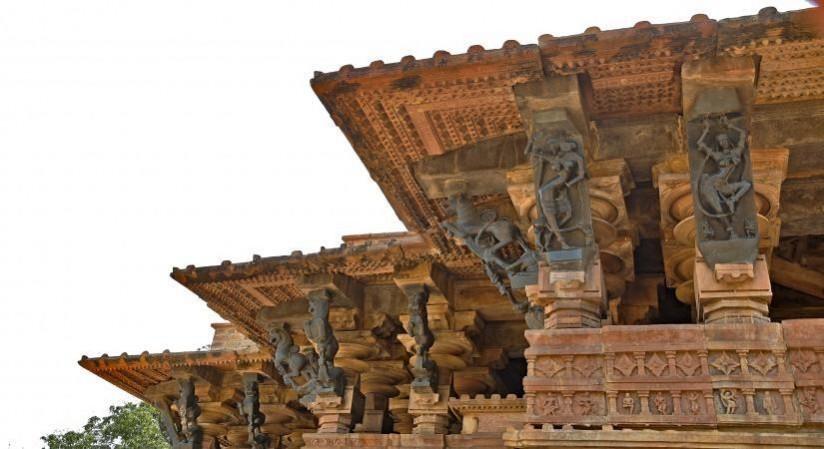Known after the sculptor, the Ramappa temple near Warangal in Telangana has finally been accredited the coveted status of UNESCO World Heritage site befitting the rich spiritual and cultural heritage of Telangana, India's youngest state.
Also known as Rudreswara temple, this Kakatiyan architectural architectural marvel is located 200 km from Hyderabad, at Palampet in Mulugu district near Warangal, about 200 km from Hyderabad.
"Today, because of a historic decision taken at the 44th session of the World Heritage Committee, Ramappa temple now belongs to the whole world, to the entire humanity. I congratulate the people of Palampet," India's representative at the online session of the World Heritage Committee (WHC) announced on Sunday.
Seventeen countries including Russia, Oman, Brazil, Saudi, Egypt, Spain, Thailand, Hungary, Ethiopia and China described Ramappa as an outstanding heritage site and a manifestation of the master of human geniuses at the session.

UNESCO's description of the Temple:
"Construction of the sandstone temple began in 1213 CE and is believed to have continued over some 40 years. The building features decorated beams and pillars of carved granite and dolerite with a distinctive and pyramidal Vimana (horizontally stepped tower) made of lightweight porous bricks, so-called 'floating bricks', which reduced the weight of the roof structures.
"The temple's sculptures of high artistic quality illustrate regional dance customs and Kakatiyan culture. Located at the foothills of a forested area and amidst agricultural fields, close to the shores of the Ramappa Cheruvu, a Kakatiya-built water reservoir, the choice of setting for the edifice followed the ideology and practice sanctioned in dharmic texts that temples are to be constructed to form an integral part of a natural setting, including hills, forests, springs, streams, lakes, catchment areas, and agricultural lands."
Ramappa temple is the 39th site in India and the first in Telangana to get the UNESCO tag and brings forth the state of Telangana's culture on to the international stage in recognition for its cultural heritage. This is the state's first major success after attaining statehood seven years ago.
Soon after the formation of Telangana, Ramappa temple was nominated for the inscription in 2014 and a team of UNESCO officials had inspected the temple in 2019. Last year, it was one of the global sites nominated for the coveted tag but the WHC meeting was delayed due to Covid-19 pandemic.
Ramappa temple's sculptor
Constructed in 1213 AD during the reign of the Kakatiya Empire by Recharla Rudra, a general of Kakatiya king Ganapati Deva, the presiding deity of the temple is Ramalingeswara Swamy. But the temple became famous with the name sculptor Ramappa who executed the work for 40 years.
The temple complexes of Kakatiyas have a distinct style, technology and decoration exhibiting the influence of the Kakatiyan sculptor. The Ramappa temple is a manifestation of this and often stands as a testimonial to the Kakatiyan creative genius.
The temple stands on a 6 feet high star-shaped platform with walls, pillars and ceilings adorned with intricate carvings that attest to the unique skill of the Kakatiyan sculptors.
The sculptural art and decoration specific to the time and Kakatiyan Empire have an outstanding universal value. The distinct style of Kakatiyas for the gateways to temple complexes, unique only to this region confirm the highly evolved proportions of aesthetics in temple and town gateways in South India.
European merchants and travelers were mesmerized by the beauty of the temple and one such traveler had remarked that the temple was the "brightest star in the galaxy of medieval temples of the Deccan".
Legal protection to Ramappa temple
According to B.V. Papa Rao of Kakatiya Heritage Trust, which led the effort to get UNESCO tag, India had reached to 24 countries to inscribe Ramappa temple as World Heritage site. The countries were presented documents to show the importance of the site. The Telangana government had also taken steps to conform to the demands made by the WHC in their agenda papers.
Two days ago, the state government announced that it is initiating formation of a management committee at the state level and Palampet Special Development Authority at the local level for adequate legal protection to the temple and to ensure regulated development by appropriately zoning areas near the temple.
State minister for tourism and culture V. Srinivas Goud stated that these steps will ensure that serenity and natural beauty of the surroundings of the temple are maintained. He announced that two temples near Ramappa will also be brought under the jurisdiction of Ramappa temple property as recommended by the International Council on Monuments and Sites.
On Saturday, five cultural sites, including one transnational property, in Saudi Arabia, Austria, Belgium, Czechia, France, Germany, Italy, United Kingdom of Great Britain and Northern Ireland were inscribed onto the UNESCO's World Heritage List. The process is scheduled to continue through July 28.
(With inputs from IANS)















